1993 BUICK ROADMASTER steering
[x] Cancel search: steeringPage 39 of 340
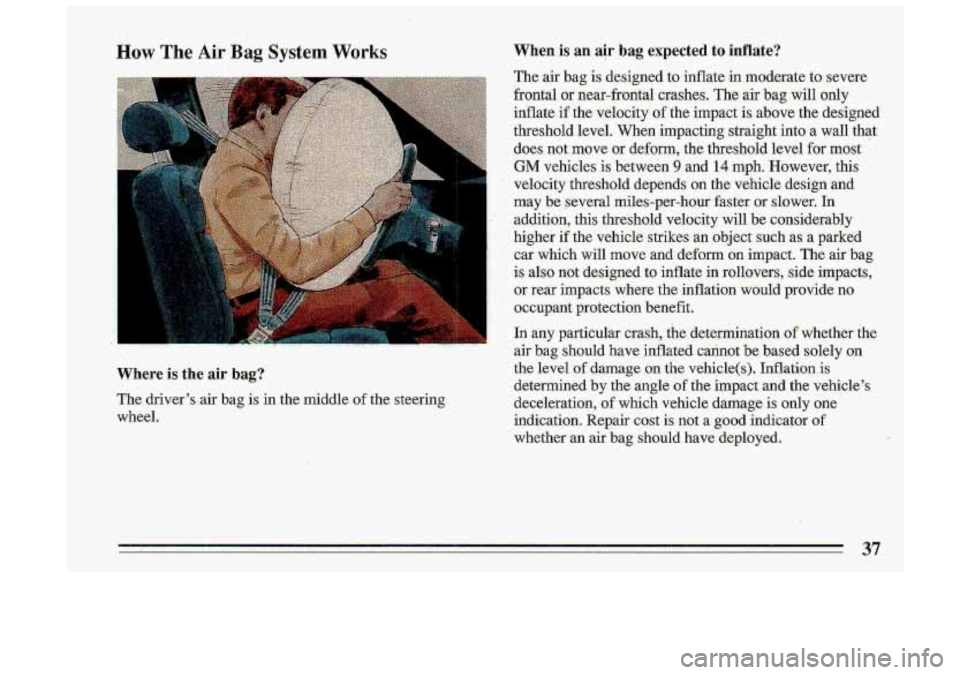
How The Air Bag System Works
Where is the air bag?
The driver’s air bag is in the middle of the steering
wheel.
When is an air bag expected to inflate?
The air bag is designed to inflate ,in moderate to severe
frontal or near-fontal crashes. The air bag
will only
inflate if the velocity of the impact is above the designed
threshold level. When impacting straight into a wall that
does not’move or deform, the threshold level for most
GM vehicles is between 9 and 14 mph. However, this
velocity threshold depends
on the vehicle design and
may be several miles-per-hour faster or slower. In
addition, this threshold velocity will be considerably
higher
if the vehicle strikes an object such as a parked
car which will move and defonn
on impact. The air bag
is also not designed to inflate in rollovers, side impacts,
or rear impacts where the inflation would provide no
occupant protection benefit.
In any particular crash, the determination of-whether the
air bag should have inflated cannot be based solely on
the level
of damage on the vehicle(s). Inflation i,s
determined by the angle of the impact and the vehicle’s
deceleration,
of which vehicle damage is only one
indication. Repair cost
is not a good indicator of
whether an air bag should have deployed.
37
Page 42 of 340
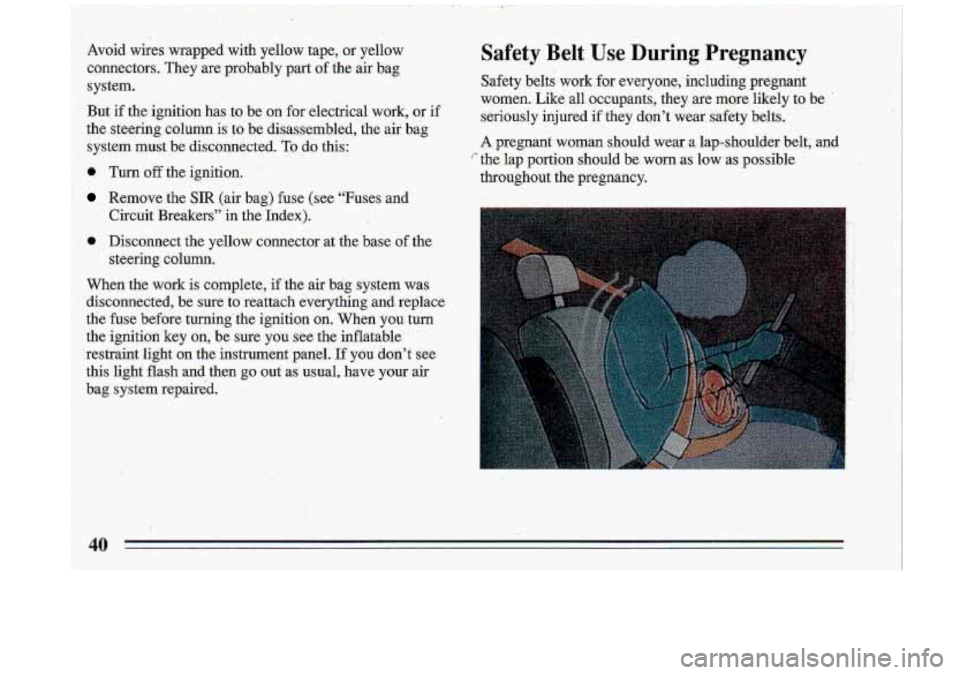
Avoid wires wrapped with yellow tape, or yellow
connectors. They are probably part
of the air bag
Bystem. But if the ignition has .to be on for electrical work,
or if
the steering column is to be disassembled, the air bag
s-ystem must be disconnected. To do this:
@ Turn off the ignition. ' '
Remove the SIR (air bag) fuse (see "Fuses and
a Disconnect the yellow-connector at the base of the
. steering column.
when the work
is complete, if the air bag system was
disconnected, be sure
to reattach everything and replace
:,the fuse before turning' the ignition on. When
you turn
the ignition key on, be. sure you see the inflatable
'restraint light on the instrument panel.
If you don't see
this light flash and then
go out as usual, have your air
bag system repaired. Circuit Breakers" in the Index).
Safety Belt Use During Pregnancy
Safety belts work for
everyone, including pregnant
women. Like all occupants, they are more likely to be
'
seriously injured if they don't wear safety belts.
A pregnant woman should wear a lap-shoulder belt, and
the lap portion should be worn as low .as possible
throughout the pregnancy.
40
Page 63 of 340
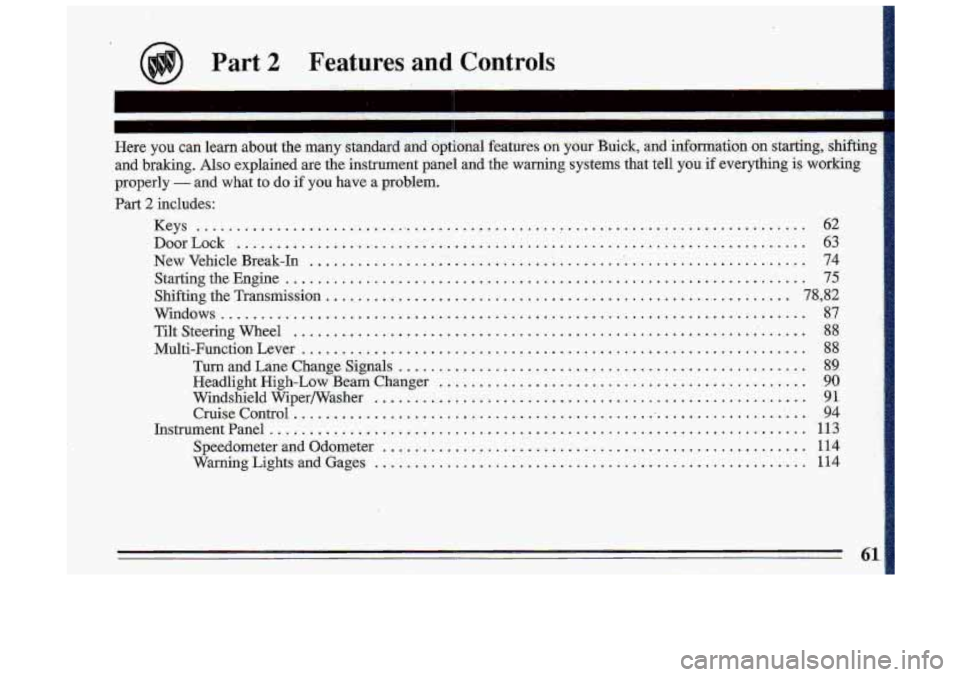
Part 2 Feat.ures and Controls
n .
Here you can learn about the many standard and optional features on your Buick, and infom.ation on starting. shifting
and braking
. Also explained are the instrument panel and the warning systems that tell you if everything is working
properly
. and what to do if you have a problem .
Part 2 includes:
Keys
........................................................................\
..... 62
DoorLock ....................................................................... \
63
New Vehicle Break-In ............................................................... 74
Starting the Engine
................................................................. 75
Shifting the Transmission
.......................................................... 78, 82
Windows ........................................................................\
. 87
TiltSteeringWheel
................................................................ 88
Multi-IFunctionLever ............................................................... 88
TurnandLaneChangeSignals ................................................... 89
Headlight High-Low Beam Changer .............................................. 90
Windshield WiperWasher
....................................................... 91
Cruise Control
.................................................................. 94
Instrument Panel
................................................................... 1 13
Speedometer and Odometer
..................................................... 114
Warning Lights and Gages
...................................................... 114
61
.
Page 74 of 340

Theft
Vehicle theft is big business, especially in some cities.
Although your Buick has
a number of the€t deterrent
features, we know that nothing we put on it can make
it
impossible to steal. However, there are ways y6U can
help.
Kev in t~he ignition: If you walk away from your
vehicle with the keys inside, it's an easy'target for joy%..
riders or professional thieves - so don't do it. wyqw. .:: %3: F: ;-;.::. *.'%(:.
When you park your Buick and open'the diiver 's'door,
you'll hear a tone reminding you'to remove your key
from the ignition and take it with you.' Always
do this..
Your steering wheel will be locked, and
so will your
ignition and transmission. And remember to lock the
doors.
.. .L: . . *:*.a ;*;,,,
Parking at Night: Park in a lighted spot, close all
windows and lock your vehicle. Remember to keep your
valuables out
of sight. Put them in a storage area, -or take
them with you.
Page 91 of 340
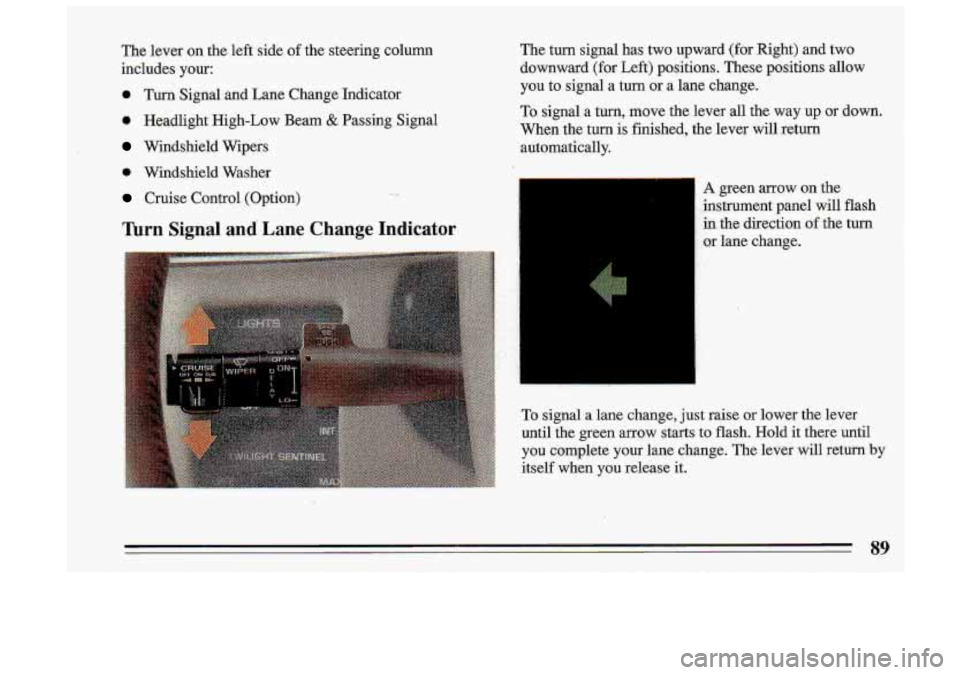
The lever on the left side of the steering column
includes your:
0 Turn Signal and Lane Change Indicator
0 Headlight High-Low Beam & Passing Signal
Windshield Wipers The
turn signal has two upward (for Right) and two
downward (for Left) positions. These positions allow
you to signal a turn or a lane change.
To signal a turn, move the lever all the way up or down.
When the turn is finished, the lever will return
automatically.
0 Windshield Washer
Cruise Control (Option) instrument panel will flash
Turn Signal and Lane Change Indicator , ' in the direction of the turn
.-- A green arrow on the
I .or lane change.
To signal a lane change, just raise
or lower the lever
until the green arrow starts
to flash. Hold it there until
you complete your lane change. The lever will return by
itself when you release it.
Page 153 of 340
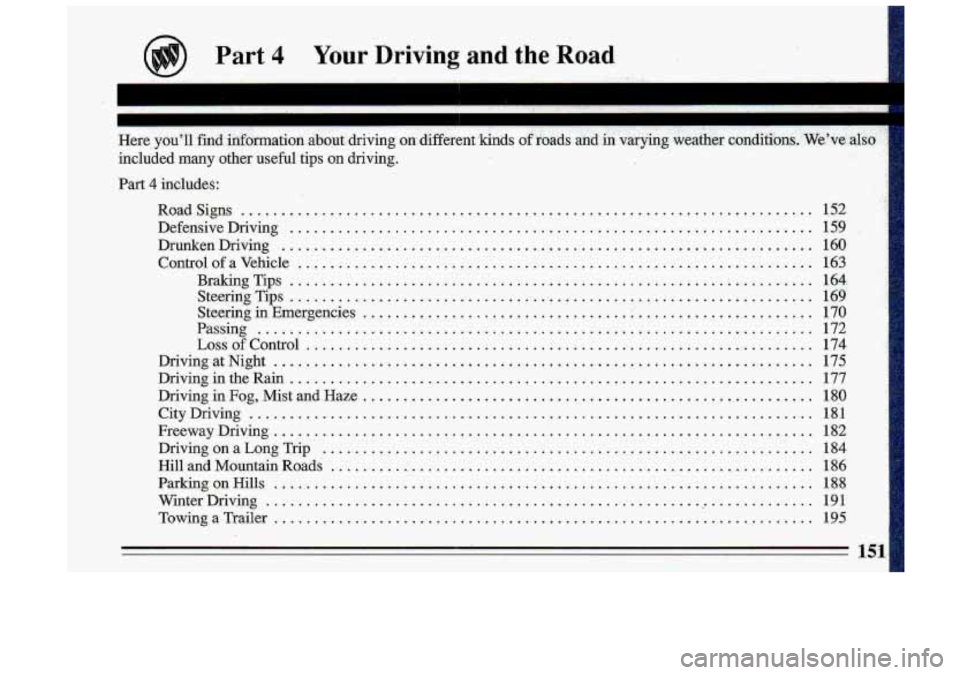
Part 4 Your Driving and the Road
Part 4 includes:
RoadSigns
........................................................................\
DefensiveDriving .................................................................
DrunkenDriving ...................................................................
ControlofaVehicle ................................................................
BrakingTips .................................................................
SteeririgTips .................................................................
Steering in Emergencies ................................. I ......................
Passing .....................................................................
Loss of Control ...............................................................
DrivingatNight ...................................................................
DrivingintheRain .................................................................
Driving in Fog, Mist and Haze .........................................................
FreewayDriving ....................................................................
DrivingonaLongTrip ..............................................................
Hill and Mountain Roads ............................................................
ParkingonHills ...................................................................
WinterDriving .....................................................................
CityDriving ......................................................................
TowingaTrailer ...................................................................
Page 165 of 340

might not be able to react quickly enough to avoid the
collision.
There’s something else about drinking and driving that
many people don’t know. Medical research shows that
alcohol in a person’s system can make crash injuries worse. That’s especially true for brain, spinal cord and
heart injuries. That means that
if anyone who has been
drinking
- driver or passenger - is in a crash, the
chance of being killed or permanently disabled is higher
than
if that person had not been drinking. And we’ve
already-seen that the chance
of a crash itself is higher for
drinking drivers.
1- -
/q CAUTION:
Drinking and then driving is very dangerous.
Your reflexes, perceptions, and judgment
will be
affected by even a small amount
04 alcohol. You
could have a serious - or even fatall - accident
if you drive after drinking. Please don’t drink
and drive or ride with a driver who has been
drinking. Ride home
in a cab; or if you’re with a
group, designate a driver who will not drink.
Control of a Vehicle
You have three systems that make your vehicle go where
you want it to
go. They are the brakes, the steering and
the accelerator. All three systems have to
do their work
at the places where the tires meet the road.
Sometimes, as
when you’re driving on snow or ice, it’s
easy to ask more of those control systems than the tires
and road
can provide. That means you can lose control
of your vehicle.
163
Page 171 of 340
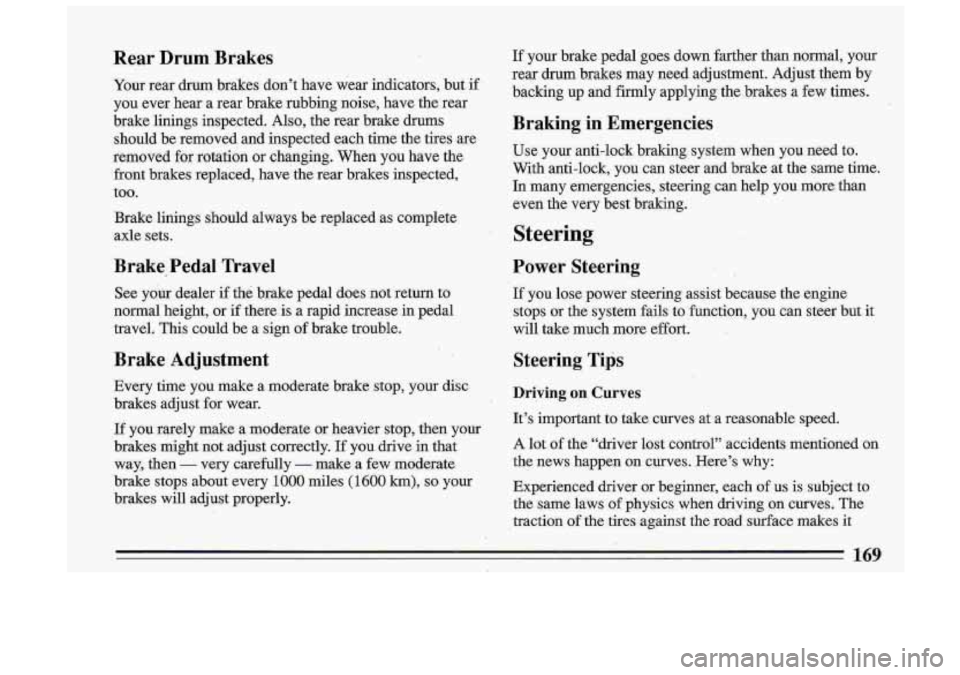
If your brake pedal goes down farther man normal, your
rear drum brakes may need adjustment. Adjust them by
backing
up and firmly applying the brakes a few times.
I
Braking in Emergencies I
Use your anti-lock braking sysKem when you need to. .
With anti-lock, you can steer and brake at the same time.
In many emergencies, steering can help you .more. than
even the very best braking.
Steering
Power Steering
If you lose power steering a ssist becau Lse
the engine
stops or the system fails to function, you can steer but
it
will take much more effort.
Steering Tips
Driving on Curves
It’s important to take- curves at a reasonable speed.
A lot of the “driver lost control” accidents mentioned on
the news happen on curves. Here’s why:
Experienced driver or beginner, each
of us is subject to
the same laws of physics. when driviqg on curves. The
traction
of the tires agairist the road s.urface makes it
169